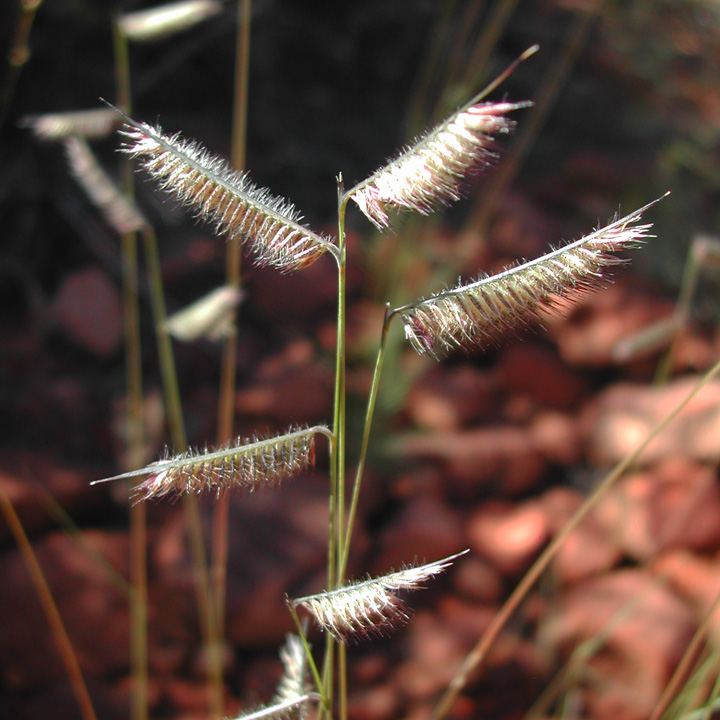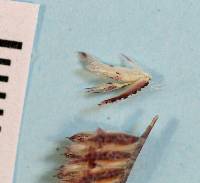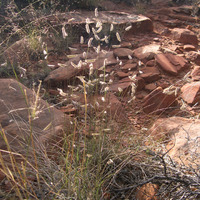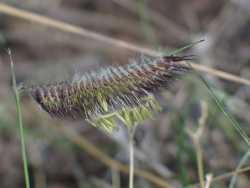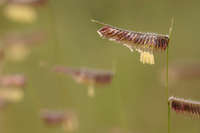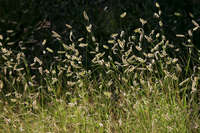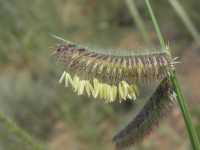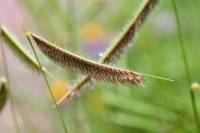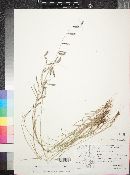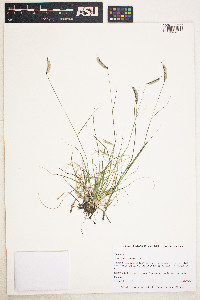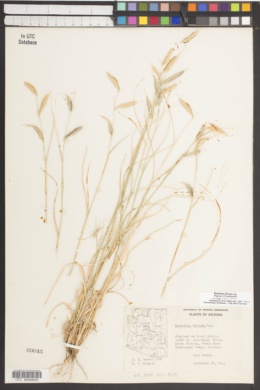|
|
|
|
Family: Poaceae
hairy grama
[Bouteloua glandulosa (Cerv.) Swallen, moreBouteloua hirsuta var. glandulosa (Cerv.) Gould, Chondrosum hirsutum (Lag.) Sweet] |
Plants perennial; densely or loosely cespitose, occasionally stoloniferous. Culms 15-75 cm, erect or decumbent, sometimes branched basally, sometimes branched aerially; nodes 3-6; internodes glabrous or sparsely to densely pubescent with papillose-based hairs. Leaves basal or mainly cauline; sheaths mostly glabrous, finely scabrous, or pubescent, pilose near the ligules; ligules 0.2-0.5 mm, of hairs; blades 1-30 cm long, 1-2.5 mm wide, flat to involute, papillose-based hairs often present on both surfaces, usually present on the bases of the margins. Panicles usually with 0.7-18 cm rachises bearing 1-6 branches, the branches sometimes digitate; branches 10-40 mm, persistent, straight, with 20-50 spikelets, axes extending 5-10 mm beyond base of the terminal spikelets; disarticulation above the glumes. Spikelets pectinate, green to dark purple, with 1 bisexual floret and 1-2 rudimentary florets. Glumes acuminate or awn-tipped; lower glumes 1.4-3.5 mm; upper glumes 3-6 mm, midveins with papillose-based hairs; lowest lemmas 2-4.5 mm, pubescent, 1-3-awned, central (or only) awns 0.2-2.5 mm, not flanked by membranous lobes, lateral lobes acuminate, unawned or with awns no longer than the central awn; lower paleas ovate, unawned; anthers 2-3.4 mm, cream or yellow; rachilla internodes subtending second florets glabrous or pubescent, sometimes with a distal tuft of hairs; second lemmas 0.5-2 mm, bilobed, 3-awned, awns 2-4(6) mm; third lemmas, if present, minute, membranous scales, glabrous. Caryopses 1.5-2.6 mm. 2n = 20, 40, 50, 60; numerous dysploid numbers also reported. Bouteloua hirsuta is a widespread species, with two subspecies that frequently hybridize in areas of sympatry (Wipff and Jones 1996). Perennial densely to loosely tufted herb, sometimes with runners 15 cm - 0.97 m tall Leaves: mostly along culm but also basal. The sheath surface is mostly hairless to finely rough or hairy, and is softly hairy near the 0.2 - 0.5 mm long ligule, which is composed of hairs. Blade 1 - 30 cm long, 1 - 2.5 mm wide, flat or with margins rolling toward the upper surface of the midvein (involute), usually with warty-based hairs. Inflorescence: branched (panicle), with one to six branches borne on a stalk 0.7 - 18 cm long or sometimes arising from a common point (digitate). The straight branches are 1 - 4 cm long and extend 5 - 10 mm past the base of the uppermost spikelet. Fruit: a caryopsis, 1.5 - 2.6 mm long. Culm: 15 cm - 0.75 m long, erect or decumbent, sometimes branching near base or above, with three to six nodes and internodes that are hairless or have warty-based hairs. Spikelets: 20 to 50 per branch, arranged on one side of the axis, green to dark purple. Glumes: unequal, pointed or awn-tipped, single-veined, the midvein having warty-based hairs, with the lower glume 1.4 - 3.5 mm long and the upper glume 3 - 6 mm long. Florets: two or three per spikelet, with one bisexual and one or two poorly developed and sterile. Bisexual florets have cream-colored or yellow, 2 - 3.4 mm long anthers. Lemma: of bisexual floret 2 - 4.5 mm long and hairy, with the middle lobe having a 0.2 - 2.5 mm awn and the lateral lobes either pointed or with awns shorter than the middle awn. The lemma of each sterlie floret (if present) is 0.5 - 2 mm long, two-lobed and three-awned or reduced to a tiny membranous scale. Palea: unawned and egg-shaped on bisexual floret, absent on sterile floret. Similar species: Bouteloua curtipendula differs by having many more branches (twelve to 80) on a longer stalk (13 - 30 cm) and only one to fifteen spikelets per branch. Bouteloua gracilis has more spikelets per branch (40 to 130) and the branch axis terminates with a spikelet. Flowering: July to September Habitat and ecology: Very rare in sandy prairies. Occurence in the Chicago region: native Etymology: Bouteloua is named after Spanish botanists and brothers, Claudio (1774-1842) and Esteban (1776-1813) Boutelou y Soldevilla. Hirsuta means "stiff-haired." Author: The Morton Arboretum Densely tufted perennial 1.5-6 dm; lvs mostly crowded toward the base; sheaths pilose at the throat; blades flat, 1-3 mm wide; spikes 1-3, usually 2, straight or recurved,
2-4 cm; rachis projecting 2-5 mm beyond the uppermost spikelet as a straight stiff point; spikelets numerous, closely imbricate, divergent; first glume subulate; second glume lanceolate, 3-4 mm, densely papillose- hirsute on the prominent midvein; fertile lemma about equaling the second glume, sparsely villous throughout, its awn short and flattened; vestige long-stipitate, glabrous at base, obconic, often reaching the summit of the second glume, its 3 awns equal, exceeding the tips of the fertile lemma and second glume; 2n=12-50. Dry prairies and sand-hills; Wis. and Ill. to N.D., s. and w. to Tex., Calif., and Mex.; Fla. Gleason, Henry A. & Cronquist, Arthur J. 1991. Manual of vascular plants of northeastern United States and adjacent Canada. lxxv + 910 pp. ©The New York Botanical Garden. All rights reserved. Used by permission. FNA 2003, Gould 1980 Common Name: hairy grama Duration: Perennial Nativity: Native Lifeform: Graminoid General: Moderately tufted perennial grass, occasionally stoloniferous, stems 15-75 cm, erect or decumbent, sometimes branched basally, sometimes branching aerially; internodes glabrous or sparsely to densely pubescent. Vegetative: Leaf blades sparsely papillose-hirsute or ciliate, basal or cauline, 1-30 cm long, 1-2.5 mm wide, flat to involute; sheaths glabrous, pilose near ligules; ligules ciliate < 0.5 mm. Inflorescence: Panicles with 1-18 cm rachises with 1-6 branches, sometimes digitate; rachis curved or deflexed at stout, pubescent base; branches 1-4 cm with 20-50 pectinate spikelets; axes extending 5-10 mm beyond base of the terminal spikelets; disarticlation above glumes; glumes unequal, lanceolate, awn-tipped; spikelets green to dark purple; lemma usually 4-5 mm long, more or less appressed-pubescent; rachilla internodes subtending second florets glabrous or pubescent, sometimes with a distal tuft of hairs. Ecology: Found on rocky slopes, open plains, and shaded openings in woods often on rocky soils; 4,000-6,500 ft (1219-1981 m); flowers August-October. Distribution: Most of N. America from s CAN south to s MEX Notes: An erect to slightly decumbent, loose bunchgrass distinguished by the inflorescence branches which extend beyond the spikelets (see pics). Similar in appearance to B. gracilis but in that species the center stalk of each inflorescence branch does not stick out beyond the last spikelet. Ethnobotany: Used ceremonially and as fodder. Etymology: Bouteloua named for brothers Claudio (1774-1842) and Esteban (1776-1813) Boutelou Agraz, Spanish botanists and horticulturalists; hirsuta means covered with hair. Synonyms: None Editor: SBuckley 2010, FSCoburn 2014, AHazelton 2015 |
|
|
|


